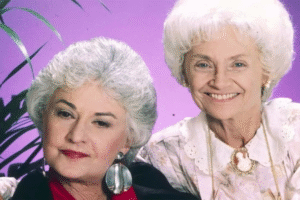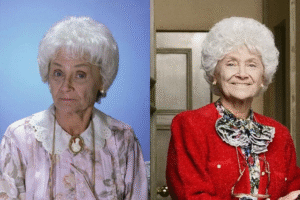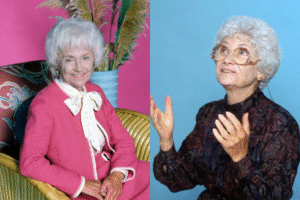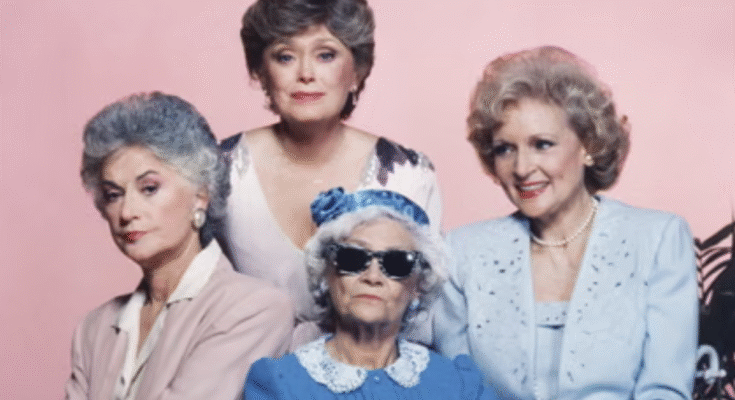Introduction: The Truth-Telling Force of Nature
Sophia Petrillo burst onto television screens as a force of nature who shattered every stereotype about elderly women in media. Portrayed by Estelle Getty in NBC’s “The Golden Girls” (1985-1992), Sophia transformed what could have been a marginal grandmother role into one of television’s most beloved characters. With her signature wicker purse, no-nonsense attitude, and stories that began with “Picture it,” Sophia became the unexpected heart and sharp-tongued conscience of the series.
At 80-something years old, Sophia was supposedly the eldest of the Golden Girls, yet she possessed more vitality, schemes, and romantic adventures than women half her age. Her stroke-damaged filter that caused her to speak without restraint became television gold, allowing the show to address topics and deliver truths that other characters couldn’t voice. She wasn’t just comic relief or wise elder; she was a fully realized character whose advanced age enhanced rather than limited her narrative possibilities.
Early Life in Sicily
The Old Country
Sophia Grisanti was born in a small village in Sicily in the early 1900s, growing up in poverty that shaped her pragmatic worldview and resourceful nature. Her stories of Sicily painted a picture of a harsh but vibrant world where survival required wit, determination, and occasionally creative interpretation of the law.
Life in Sicily during Sophia’s youth meant dealing with poverty, limited opportunities for women, and the constant presence of both tradition and danger. Her tales of village life, while often exaggerated for effect, revealed genuine hardships: hunger, disease, limited education, and the struggle for daily survival that marked early 20th century rural Italian life.
Family and Traditions
The Grisanti family, as Sophia described them, were a colorful cast of characters whose influence shaped her personality. Her mother, occasionally mentioned in stories, taught her the importance of family loyalty and the power of guilt as a parenting tool. Her father, a simple man trying to provide for his family, demonstrated that dignity could be maintained even in poverty.
Sophia’s stories of siblings and extended family revealed the complex dynamics of Italian family life: fierce loyalty coupled with intense rivalry, deep love expressed through criticism, and the understanding that family bonds transcended any disagreement or distance.
The Village Experience
Growing up in a small Sicilian village gave Sophia a unique perspective on community, tradition, and human nature. Her stories of village characters—from the woman who thought she was a chicken to the man who invented pizza—might have been embellished, but they revealed truths about human eccentricity and community acceptance of difference.
These early experiences taught Sophia that everyone has their struggles, that kindness and cruelty exist in equal measure, and that survival often requires both toughness and humor—lessons she would carry throughout her long life.
Immigration to America
The Journey
Sophia’s immigration to America as a young woman represented the classic immigrant experience of millions of Italians in the early 20th century. Leaving everything familiar for an unknown country where she didn’t speak the language required courage that Sophia would draw upon throughout her life.
The journey itself, crossing the Atlantic in steerage, arriving at Ellis Island, and facing the challenge of starting over in a new country, shaped Sophia’s understanding of struggle and opportunity. Her stories of early days in America revealed both the excitement of possibility and the pain of leaving one’s homeland.
Adapting to American Life
Learning English, understanding American customs, and navigating a new culture while maintaining Italian identity created the dual consciousness that many immigrants experience. Sophia’s imperfect English and maintained Italian traditions showed that assimilation didn’t require abandoning one’s origins.
Her experiences with discrimination against Italian immigrants, economic hardship during the Depression, and the challenge of raising American children while maintaining Old World values added depth to her character beyond simple ethnic stereotype.
Marriage to Salvadore Petrillo
Young Love
Sophia’s marriage to Salvadore “Sal” Petrillo represented both traditional arranged marriage and genuine love match. Their relationship, as Sophia described it, combined Old World tradition with New World adaptation. Sal, also a Sicilian immigrant, understood Sophia’s background and shared her values while embracing American opportunities.
Their early married life, struggling to establish themselves in Brooklyn during the Depression, showed the partnership necessary for immigrant survival. Sophia’s stories revealed a marriage built on mutual respect, shared struggle, and the deep bond that comes from facing hardship together.
Building a Family
Raising children during the Depression and World War II presented challenges that Sophia met with determination and resourcefulness. Her stories of making do with little, creating meals from almost nothing, and maintaining family stability during uncertain times revealed the strength required of that generation’s mothers.
The Petrillo family life, with children Dorothy, Phil, and Gloria, wasn’t idyllic but was held together by Sophia’s fierce love and Sal’s steady presence. The family dynamics—favoritism, guilt, manipulation, and unconditional love—reflected realistic Italian-American family patterns.

Loss and Widowhood
Sal’s death, occurring before the series began, left Sophia to navigate aging alone until circumstances brought her to live with Dorothy. Her grief for Sal, though rarely expressed directly, influenced her actions throughout the series. Her occasional conversations with his spirit showed that love transcends death and that long marriages leave permanent imprints on survivors.
The Shady Pines Years
Life in the Retirement Home
Sophia’s time at Shady Pines retirement home before moving in with Dorothy became legendary through her constant references to its horrors. Whether describing the food, staff, or fellow residents, Sophia painted Shady Pines as a nightmare that justified any behavior to avoid returning.
Yet the Shady Pines experience revealed serious issues about elder care in America. Behind the comedy lay real commentary about how society warehouses older adults, the loss of autonomy in institutional settings, and the fear many elderly people have of losing independence.
The Fire and Freedom
The fire that destroyed Shady Pines (which Sophia may or may not have caused) became her liberation story. This event brought her to Dorothy and ultimately to the house on Richmond Street, setting the series in motion. The fire represented both literal and metaphorical destruction of constraints, freeing Sophia to live her final years on her own terms.
Life at 6151 Richmond Street
The Matriarchal Role
Despite not owning the house or even being a paying roommate initially, Sophia quickly established herself as the household’s matriarch. Her age, experience, and unfiltered observations gave her authority that transcended formal arrangements. She became the moral center, truth-teller, and occasional chaos agent of the household.
Her role shifted between wise elder and mischievous child, between dependent parent and independent agent, showing that aging doesn’t mean fitting into predetermined roles. Sophia refused to be just Dorothy’s mother or the household’s grandmother; she was a full participant in all aspects of their shared life.
Relationship with Each Roommate
With Dorothy, Sophia maintained the complex mother-daughter dynamic while reversing traditional roles. She was both Dorothy’s responsibility and her guide, her burden and her blessing. Their relationship showed that parent-child bonds evolve but never simplify, regardless of age.
With Blanche, Sophia found the perfect target for her sharp tongue while secretly admiring Blanche’s confidence and sexuality. Their sparring matches revealed mutual respect beneath the insults, and Sophia’s attacks on Blanche’s ego served to keep her grounded.
With Rose, Sophia displayed protective instincts despite constantly mocking Rose’s intelligence. She recognized Rose’s vulnerability and genuine kindness, showing maternal care for the woman who was least equipped to handle life’s harshness.
The Stroke and Its Effects
Medical Reality and Comic Device
Sophia’s stroke, which allegedly destroyed the part of her brain controlling her verbal filter, provided both character explanation and narrative device. This medical event allowed Sophia to voice truths other characters couldn’t, address taboo topics, and deliver the show’s sharpest social commentary.
While played for comedy, the stroke also represented real medical challenges facing aging adults. The show acknowledged that stroke survivors face genuine changes in personality and behavior, adding medical realism to the comic premise.
Living Without Filters
Sophia’s lack of filter became her superpower, allowing her to cut through social niceties to essential truths. Her unfiltered observations about aging, death, sex, and society provided the show’s most honest moments. She could address racism, homophobia, and other prejudices directly because her medical condition provided narrative cover.
This characteristic challenged viewers to consider how much social interaction depends on polite dishonesty and whether truth-telling, even when uncomfortable, might be healthier than maintained facades.
Sophia’s Sicily Stories
“Picture It…”
Sophia’s signature phrase “Picture it…” followed by a location and date, became one of television’s most memorable catchphrases. These stories, whether about Sicily, Brooklyn, or other locations from her past, served multiple narrative functions while revealing character depth.
The stories entertained through their absurdity while often containing surprising wisdom or relevance to current situations. They showed Sophia as keeper of memory and tradition, the family storyteller whose tales preserved history even when heavily embellished.

Truth Versus Fiction
The questionable veracity of Sophia’s stories added to their charm. Whether she actually knew Mussolini, invented pizza, or experienced the various adventures she described mattered less than the truths embedded in the tales. Her stories revealed emotional if not literal truth, expressing feelings and insights through narrative rather than direct statement.
This storytelling tradition reflected both Italian cultural patterns and the immigrant experience of mythologizing the past. Sophia’s stories preserved not just personal history but cultural memory, even when that memory was creatively reconstructed.
Wisdom Through Narrative
Despite their apparent irrelevance, Sophia’s stories often provided exactly the wisdom or perspective needed for current situations. Her indirect approach to advice-giving through storytelling showed sophisticated understanding of how people accept guidance more easily through narrative than direct instruction.
Romantic Life and Sexuality
Senior Sexuality
Sophia’s active romantic life challenged stereotypes about elderly sexuality more radically than even Blanche’s adventures. At 80-plus years old, Sophia dated, had boyfriends, and pursued romance with enthusiasm that showed sexuality doesn’t have an expiration date.
Her relationships with men like Rocco, Angelo, and others demonstrated that desire, companionship, and romantic love remain important throughout life. The show treated her romantic pursuits seriously, not just as comedy, validating elderly sexuality in groundbreaking ways.
The Marriage to Max Weinstock
Sophia’s marriage to Max Weinstock, though brief due to his death, showed that new love and commitment are possible at any age. Their whirlwind romance and wedding demonstrated that elderly people deserve full romantic narratives, not just nostalgic memories of past love.
This storyline challenged assumptions about elderly romance being purely companionate, showing that passion and excitement can exist in relationships between octogenarians.
Family Relationships
Dorothy: The Complex Mother-Daughter Dynamic
Sophia’s relationship with Dorothy formed the series’ emotional backbone. Their role reversal, with Dorothy often parenting her mother while Sophia provided wisdom and guidance, reflected real dynamics in aging families. Their conflicts over independence, respect, and control showed that parent-child tensions don’t disappear with age.
Yet their deep love and mutual dependence revealed the enduring power of maternal bonds. Sophia’s pride in Dorothy’s intelligence, her fierce protectiveness, and her ability to both comfort and challenge her daughter showed masterful portrayal of complex familial love.
Phil: The Cross-Dressing Son
Sophia’s relationship with her deceased son Phil, who was a cross-dresser, provided surprising depth and progressive messaging. Her struggle to understand and accept Phil’s identity while maintaining love for him showed that even traditional, elderly people can grow in understanding.
Her eventual acceptance and defense of Phil’s memory demonstrated that parental love can transcend confusion or disappointment about children’s choices, a powerful message for LGBTQ+ viewers and their families.
Gloria and Angela
Sophia’s relationships with her other daughter Gloria and sister Angela revealed family dynamics beyond the central Dorothy relationship. The sibling rivalries, jealousies, and competitive mothering showed that family complications don’t simplify with age.
Her interactions with Angela particularly demonstrated that sibling rivalry can persist into the 80s, but also that shared history creates bonds that transcend any conflict.
Social Commentary and Wisdom
Addressing Social Issues
Through Sophia’s unfiltered observations, the show addressed racism, homophobia, ageism, and other prejudices directly. Her old-fashioned attitudes combined with surprising progressiveness showed that aging doesn’t mean ideological rigidity and that wisdom can coexist with prejudice.
Her evolution on various social issues throughout the series demonstrated that elderly people can continue learning and changing their views, challenging stereotypes about older adults being unable to adapt to social progress.
Economic Realities

Sophia’s constant schemes to make money—from selling sandwiches to various business ventures—highlighted the economic vulnerability of elderly Americans. Her fixed income, medical expenses, and need to contribute financially revealed real challenges facing aging populations.
These storylines addressed senior poverty, the inadequacy of social safety nets, and the dignity issues around financial dependence in old age, all while maintaining humor.
Healthcare and Aging
Sophia’s various health scares and medical needs throughout the series provided commentary on healthcare for the elderly. Her experiences with doctors, hospitals, and medical systems revealed both comedy and serious critique of how medicine treats older adults.
Her resistance to medical authority and insistence on being treated as a full person rather than just an old body challenged medical paternalism and advocated for patient autonomy.
Cultural Identity and Assimilation
Maintaining Italian Identity
Despite decades in America, Sophia maintained strong Italian identity through food, language, traditions, and values. Her cooking, her occasional Italian phrases, and her Old World sensibilities showed that assimilation doesn’t require abandoning origins.
Her pride in Italian heritage while being fully American demonstrated the immigrant success story: maintaining cultural identity while embracing American opportunity. This dual identity resonated with viewers from various ethnic backgrounds.
Bridging Generations
Sophia served as bridge between Old World and New, between traditional values and modern life. Her ability to adapt to contemporary Miami while maintaining Sicilian wisdom showed that tradition and progress need not be oppositional.
Her role as cultural translator, explaining Italian traditions to her American friends while adapting to American ways, reflected the immigrant experience of navigating between worlds.
Memorable Episodes and Storylines
“Ebbtide’s Revenge”
When Sophia’s son Phil dies, her grief and guilt over never fully accepting his cross-dressing created one of the series’ most powerful episodes. Her eventual acceptance and declaration of love showed that understanding can come even after death.
“The Days and Nights of Sophia Petrillo”
When Sophia operates a lunch business from the kitchen, the episode explored senior entrepreneurship and the desire to remain productive and relevant despite advanced age.
“Old Friends”
Sophia’s friendship with Alvin, who has Alzheimer’s, addressed cognitive decline with sensitivity while maintaining humor. Her loyalty to him despite his condition showed that friendship transcends mental capacity.
“Mother’s Day”
The exploration of Sophia’s mothering, both successes and failures, humanized her beyond the comic elder role. Her vulnerability about whether she was a good mother revealed insecurities that age doesn’t eliminate.
Estelle Getty’s Revolutionary Performance
The Youngest Playing the Oldest
The irony that Estelle Getty was the youngest actor playing the oldest character added layers to the performance. Getty’s energy and timing brought vibrancy to Sophia that challenged expectations about elderly characters being slow or diminished.
Her physical comedy, from hitting people with her purse to her distinctive walk, created a character who was physically present and dynamic despite advanced age. Getty made Sophia’s age a source of power rather than limitation.
Comic Timing and Dramatic Depth
Getty’s impeccable comic timing made Sophia’s one-liners legendary, but her dramatic performances revealed the character’s depth. She could shift from comedy to pathos seamlessly, making Sophia’s emotional moments as powerful as her comic ones.

Her ability to deliver Sophia’s stories with complete conviction, no matter how absurd, sold the character’s reality and made even the most outlandish tales believable within the show’s world.
Chemistry and Ensemble Work
Getty’s chemistry with the other actors, particularly Bea Arthur, created believable family dynamics. The mother-daughter relationship between Sophia and Dorothy felt authentic because Getty and Arthur created genuine emotional connection beneath the comedy.
Her ability to hold her own with three strong personalities while maintaining Sophia’s distinct voice showed masterful ensemble work that elevated everyone’s performance.
The Golden Palace and Beyond
New Adventures
In “The Golden Palace,” Sophia’s decision to buy a hotel with Rose and Blanche showed that adventure and new beginnings have no age limit. Her role as hotel co-owner gave her new authority and challenges, expanding her character beyond the maternal role.
Legacy Character
Sophia’s influence extended beyond “The Golden Girls” through references, homages, and the archetype she created. She proved that elderly characters could be central rather than peripheral, complex rather than simple, and dynamic rather than static.
Psychological and Sociological Analysis
The Role of the Elder
Sophia represented various elder archetypes while transcending them all. She was wise woman, trickster, matriarch, and child-like elder, showing that aging doesn’t mean fitting into single roles. Her complexity challenged Western culture’s limited narratives about elderly people.
Memory and Identity
Sophia’s role as keeper of family and cultural memory showed how elderly people serve as bridges to the past. Her stories, whether true or embellished, preserved not just facts but feelings, values, and cultural knowledge that might otherwise be lost.
Power and Agency
Despite being the oldest and theoretically most dependent, Sophia often wielded the most power in the household. Her age gave her license to speak truths, break rules, and manipulate situations in ways the younger women couldn’t. This inversion of expected power dynamics showed that age can be strength rather than weakness.
Social and Cultural Impact
Changing Perceptions of Aging
Sophia Petrillo fundamentally changed how television portrayed elderly women. She proved that advanced age could mean vitality rather than decline, that elderly characters could drive plots rather than merely react, and that octogenarians deserved full character development.
Immigrant Representation
As one of television’s few elderly immigrant characters, Sophia provided representation for millions of Americans who shared similar backgrounds. Her success in maintaining cultural identity while achieving American success provided a positive model for immigrant integration.
Intergenerational Relationships
The relationship between Sophia and her younger roommates modeled successful intergenerational living. She showed that elderly people have much to offer younger generations beyond mere wisdom, including friendship, humor, and different perspectives on life.
Fashion and Physical Presence
The Signature Look
Sophia’s consistent wardrobe—cardigans, simple dresses, and the ever-present wicker purse—created an immediately recognizable character silhouette. Her practical, comfortable clothing reflected both her age and her no-nonsense personality while maintaining dignity and style.
The purse became particularly iconic, serving as both fashion accessory and weapon. It represented Sophia’s preparedness for any situation and her ability to defend herself despite physical frailty.

Physical Comedy
Despite playing an 80-something character, Getty created physically dynamic performance. Sophia’s quick movements, purse-swinging, and energetic gestures contradicted expectations about elderly movement, showing that physical comedy isn’t limited by age.
Themes and Messages
Death and Mortality
Sophia’s comfortable relationship with mortality provided refreshing honesty about aging and death. She discussed death matter-of-factly, prepared for it pragmatically, and refused to let fear of death prevent living fully.
Her attitude toward mortality—neither morbid nor denial—modeled healthy acceptance of life’s finite nature while emphasizing the importance of living fully regardless of time remaining.
Tradition Versus Progress
Sophia embodied the tension between preserving tradition and embracing progress. She maintained Old World values while adapting to contemporary life, showing that tradition and change need not be mutually exclusive.
Family Bonds
Through Sophia, the show explored how family bonds evolve across lifespans. Her relationships demonstrated that family roles shift with age, that parent-child dynamics reverse and re-reverse, and that chosen family can be as meaningful as biological family.
The Wisdom of Sophia
Life Lessons
Sophia’s advice, whether delivered through stories or direct observation, contained genuine wisdom about life, love, and survival. Her perspectives, informed by decades of experience, offered alternatives to contemporary conventional wisdom.
Her greatest wisdom often came through example rather than words: showing that age doesn’t mean giving up, that every day offers opportunities for joy, and that maintaining humor might be the best survival strategy.
Cultural Bridge
Sophia served as bridge between past and present, between different cultures, between generations. Her ability to translate between these worlds made her invaluable to her household and to viewers navigating similar divides.
Conclusion: The Immortal Sophia
Sophia Petrillo stands as one of television’s most revolutionary characters, an 80-something Sicilian immigrant who refused to be marginalized by age, ethnicity, or gender. Through Estelle Getty’s masterful performance, Sophia became more than comic relief or wise elder—she became a full human being whose advanced age enhanced rather than limited her story.
She shattered every stereotype about elderly women: that they’re weak, dependent, asexual, irrelevant, or incapable of growth. Sophia was strong, independent, romantic, central to every plot, and constantly evolving. She proved that 80-year-olds could be television stars, that elderly characters deserved complex storylines, and that age could be a source of power rather than limitation.
Her immigrant story provided representation for millions of Americans who shared similar backgrounds. She showed that maintaining cultural identity while embracing American opportunity was possible, that broken English didn’t mean broken intelligence, and that immigrant wisdom deserved respect.
The relationship between Sophia and Dorothy provided television’s most complex mother-daughter dynamic, showing that these relationships continue evolving throughout life, that role reversals are natural, and that the parent-child bond transcends any conflict or complication.
Sophia’s stories, beginning with “Picture it,” became more than catchphrase—they became a way of understanding how narrative shapes memory, how wisdom transmits through story, and how the past informs the present. Whether true or fabricated, these stories contained emotional truth that transcended literal accuracy.
Her unfiltered observations, supposedly caused by stroke, allowed the show to address topics typically taboo on 1980s television. Through Sophia, the show could discuss death, sex, prejudice, and social issues with honesty that wouldn’t have been possible through other characters.
The character’s comfort with mortality provided radical honesty about aging and death. Sophia showed that acknowledging death’s inevitability didn’t mean living in fear, that preparing for death was practical rather than morbid, and that proximity to death could inspire rather than paralyze.
Her romantic pursuits and sexual interests at 80-plus years old broke ground in representing elderly sexuality. She proved that desire doesn’t expire, that new love is possible at any age, and that elderly people deserve full romantic narratives.
Sophia’s economic struggles and schemes highlighted real issues facing elderly Americans: insufficient fixed incomes, medical expenses, and the dignity issues around financial dependence. Her determination to contribute financially showed that productivity needs have no expiration date.
Through Sophia, “The Golden Girls” addressed healthcare, elder care, and the treatment of aging adults in America. Her resistance to being warehoused, patronized, or dismissed as irrelevant resonated with elderly viewers facing similar challenges.
The character’s influence extends far beyond the series. Sophia created new possibilities for elderly characters in television and film. She proved that advanced age could mean vitality, that elderly actors could be stars, and that stories about octogenarians could captivate audiences of all ages.
For elderly viewers, particularly elderly women, Sophia provided desperately needed representation. She showed that their stories mattered, that their lives remained interesting, and that their perspectives deserved respect. She validated their experiences while inspiring them to embrace remaining life fully.
For younger viewers, Sophia modeled successful aging and intergenerational relationships. She showed that elderly people are full human beings rather than diminished versions of their younger selves, that they have wisdom worth hearing, and that befriending across generations enriches all involved.
Sophia Petrillo remains immortal in television history, not despite her age but because of it. She proved that every stage of life has its own possibilities, that growth continues until death, and that the golden years can truly be golden. Her legacy lives on in every elderly character given full humanity, in every intergenerational friendship, and in every viewer who learned from Sophia that age is just a number—and not even a particularly important one.
“Picture it”—television before Sophia Petrillo, when elderly women were invisible or marginal. Now picture television after Sophia, where 80-something women can be stars, where elderly sexuality is acknowledged, where immigrant stories are celebrated, and where age means wisdom without requiring irrelevance. That transformation is Sophia’s greatest story, and unlike her Sicilian tales, this one is absolutely true.



